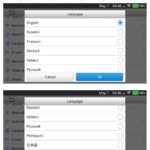A Bosch scanner is a valuable tool for diagnosing car problems, whether your vehicle uses the older OBD1 system or the newer OBD2 standard. While professional-grade scanners like Snap-on offer extensive capabilities, their cost can be prohibitive for the average DIYer. This article explores the functionalities of a Bosch scanner in relation to both OBD1 and OBD2 systems.
Understanding OBD1 and OBD2 Systems
Before delving into scanner specifics, it’s crucial to understand the differences between OBD1 and OBD2. OBD1, prevalent in vehicles manufactured before 1996, utilized various proprietary connectors and communication protocols. This lack of standardization made diagnostics challenging, often requiring specific adapters and software for each car make and model. In contrast, OBD2, introduced in 1996, standardized the diagnostic connector and communication protocol (OBD-II), simplifying the process and enabling universal compatibility.
Bosch Scanners for OBD1 Vehicles
While Bosch may not have produced dedicated handheld scanners specifically for OBD1 like the older Snap-on MT2500, their expertise in automotive diagnostics extends to this era. Using a suitable adapter and software, a Bosch diagnostic solution might be able to interface with OBD1 systems. However, accessing data on OBD1 vehicles often relies on interpreting signals from the ECU rather than direct sensor readings. Keep in mind that the data available on OBD1 systems is limited compared to OBD2.
Bosch Scanners for OBD2 Vehicles
Bosch offers a wide range of OBD2 scanners, catering to both professional mechanics and DIY enthusiasts. These scanners can retrieve and display various diagnostic trouble codes (DTCs), real-time sensor data, and perform functions like resetting the check engine light. Bosch OBD2 scanners often come with features like:
- Code Reading and Clearing: Identify and erase DTCs to diagnose and address issues.
- Live Data Streaming: Monitor real-time sensor data to analyze vehicle performance.
- Freeze Frame Data: Capture vehicle data at the moment a fault code is triggered.
- Component Testing: Activate specific components to pinpoint malfunctions.
- Vehicle Specific Data: Access manufacturer-specific data for enhanced diagnostics.
Choosing a Bosch OBD2 scanner depends on individual needs and budget. Basic code readers provide essential functionality at an affordable price, while more advanced scan tools offer comprehensive diagnostics and functionalities for professional use.
Advantages of Using a Bosch Scanner
Bosch, a renowned automotive parts and technology supplier, brings its expertise to its diagnostic tools. Key benefits of using a Bosch scanner include:
- Reliability and Accuracy: Bosch scanners are known for their accurate and reliable readings.
- Ease of Use: Many Bosch scanners feature user-friendly interfaces and intuitive software.
- Wide Vehicle Coverage: Bosch scanners support a broad range of car makes and models.
- Affordability: Bosch offers scanners across different price points to suit various budgets.
Conclusion
Whether you need to diagnose an older OBD1 vehicle or a modern OBD2 car, a Bosch scanner can be a valuable tool. While navigating OBD1 systems may require adapters and specific software, Bosch’s expertise in automotive diagnostics ensures reliable results. For OBD2 vehicles, Bosch provides a comprehensive range of scanners to meet the needs of DIYers and professionals alike. Consider your specific requirements and budget when selecting a Bosch scanner to ensure it fulfills your diagnostic needs.

